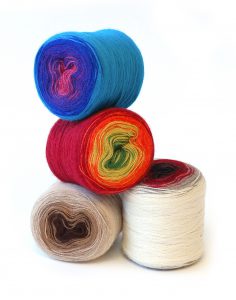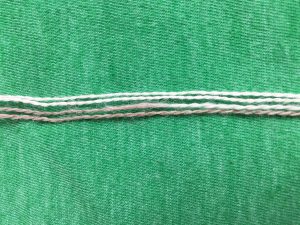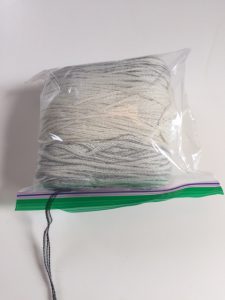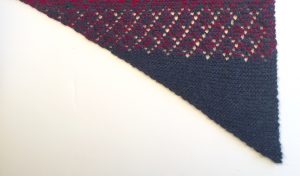Welcome to the Progressive Needles Knit Along sponsored by Skacel Collection. Transient is a great new pattern designed to showcase the gradient colors found in HiKoo’s Concentric yarn. Before we begin, here is an overview of the KAL:
- A portion of the 4-part mystery pattern is revealed here on the 1st, 2nd, 3rd and 4th Thursdays in April at 9am Eastern time. The weekly pattern, video resources and lots of helpful tips are included in each post. An abbreviated, pattern-only version is included to download.
- All techniques are supported with video instruction at knitpurlhunter.com
- All questions and comments are monitored daily both here and in the Knit Purl Hunter group on Ravelry. It’s like having your own private knitting tutor!
- Projects completed by May 15 are eligible for the monthly prize drawing – first prize is a set of addi Clicks! See skacelknitting.com for all the info.
- VERY IMPORTANT: Transient is a FREE pattern through May 31. After this date, it will only be available for purchase on Ravelry. Be sure to download each portion of the pattern prior to this date. Saving it to your Ravelry page will NOT save the pattern. The helpful tips and videos for each section will remain on my website indefinitely.
The Yarn
No doubt you have been gazing at your lovely cake of yarn and wondering how it achieves its uniform color gradience. Concentric is comprised of four, thin plies of yarn that are left untwisted. All four of these plies are held together while knitting to create a worsted weight yarn. At the beginning of the skein (whether from the outside or the inside), there are four strands of the same color. We will name that AAAA – 4 strands of Color A. At the end of 30 meters (approx. 33 yards), one of the plies will change to the next color (color B). We will call that AAAB – 3 strands of Color A and 1 strand of Color B. At the end of the next 30 meters, the plies change to 2 strands of Color A and 2 strands of Color B – AABB (seen below).
After another 30 meters, another strand is changed leaving 1 strand of Color A and 3 strands of Color B – ABBB. Lastly, the final 30 meters brings the color to all 4 strands in Color B – BBBB. This exact coloring pattern occurs through 13 changes ending with DDDD. I have spelled out the sequence in the Pattern Notes below for your reference.
Each section in the pattern will deal with one or more of these colorways. For those knitters unable to use Concentric, follow the pattern instructions as written unless otherwise indicated in the directions.
Concentric may be knit from the inside or the outside of the skein. Since the colors change every 30 meters, the direction that the yarn is used has no impact on the the pattern. If you choose to knit from the inside of the skein, I recommend placing it inside of a ziploc bag and feeding the yarn through the top of the bag to contain the skein as the yardage diminishes.
Shawl Basics
Transient is an asymmetrical triangle that allows it to be worn in many ways. (See Schematic below) The triangle gets its shape by increasing one stitch on every row at the same edge. In other words, on right side rows, an increase is worked into the last stitch of the row. The worked is then turned and an increase is worked into the first stitch of this wrong side row. All increases are worked at this edge as a kfb – knit front and back.
The shawl is completely reversible so it is very helpful to hang a marker on the right side of the fabric to avoid confusion.
I found a row counter to be an essential tool in this project. Many of the stitch patterns are simple and it is easy to cruise along paying no attention to the row number. Should you lose track of your row count, I have a few tips for you. After completing a right side row, there will be an odd number of stitches on the needle. After completing a wrong side row, there will be an even number of stitches on the needle. If you have lost your row count completely, a little math will get you back on track. There will be two more stitches on the needle than the number of the last completed row. Example: If there are 75 stitches on the needle, then the last completed row is Row 73.
Gauge Swatches Are Liars!
While I try to always speak kindly, it is hard to hold my tongue in the face of traitorous gauge swatches. Many times I have knit a great big swatch, measured diligently several times, only to find that once I start the project my gauge has changed. What are we knitters to do in the face of these evil liars?
The truth of the matter is that we have human hands that are handcrafting thousands of stitches. Unlike a machine, each stitch is uniform but not exactly the same. Stitches change with mood, comfort level, temperature, humidity, stitch familiarity, and needle material. Once we accept this fact, gauges should be thought of as a first attempt at stitch counts. A knitter should always check gauge again as the project is underway to once again evaluate the stitches.
Part One is a very short knit to provide ample time to check your gauge and reknit if necessary. There is NO danger in running out of yarn. Everyone will knit the shawl until all of the yarn is used. (This will make so much more sense as the pattern is revealed – have faith!) Should you need to reevaluate your gauge, watch my Gauge in Garter Stitch video for an accurate assessment.
Gauge and Section 1
The first section of Transient is worked in simple garter stitch to anchor this end of the shawl. The goal is to finish the section at or near the end of Color AAAA. I knit three shawls and each of them ended with a different amount of AAAA yarn remaining at the end of Section 1. That’s right – same person, same needles, same yarn and I used a different amount of yarn each time. I ended up with 1/2 yard to 3 yards of AAAA at the end of Section 1 in each of my samples. I recommend starting with your swatch needle size or perhaps one larger if you went down two or more sizes. Work Section 1 and then evaluate how much length you have remaining in AAAA. If you have less than 3 yards of AAAA then I would just continue with that needle size. If you have more than 3 yards, I would try again on a larger needle. Conversely, if you started into AAAB on the last row or two of Section 1 that is fine as well.
Every knitter must stop at the end of Row 52 with 54 stitches to set the stage for the lace in the upcoming section. If you are not satisfied with the stopping point in your yarn, you can unravel and reknit on a different needle, cut your yarn to “cheat” and hurry up the color change, or merrily ignore all of this business and knit on.
Please know that stitch counts and exact stopping points will only occur in Parts 1 and 2 (weeks 1 & 2) of the KAL. The larger areas in Parts 3 and 4 (weeks 3 & 4) will have you ignoring stitch counts, letting the colors be the boss. I will reveal this bit of magic later:)
Section 1 – AAAA
Unravel your gauge swatch as all of the skein is needed for the shawl. Tie a simple knot near the end of your yarn to corral the four plies and prevent one yarn from scooting ahead of the others. Cast on 2 stitches, leaving an 8″ tail to weave in later. Work Rows 1 – 52. At this point you can compare your yarn usage with the pattern and determine if another needle size is needed.
Section 2 – AAAB
Section 2 features a garter diamond lace pattern that is comprised of simple increases and decreases. If you are new to lace knitting, rest assured that this small section is as tough as it gets in this shawl. We have stretches of delightfully relaxing and beautiful stitches ahead in the shawl!
In addition to the single decreases k2tog and ssk, this section uses the double decrease k3tog tbl – knit three together through the back loop. While this stitch is rather simple to execute, sharp needle tips make this decrease a snap to work.
A few tips for Section 2:
- In all of my shawls, the yarn changed to AAAB somewhere in Row 54. Don’t worry if yours is slightly different!
- To avoid excessive counting, place a removable marker after the first 50 stitches from the beginning of the right side row. As your shawl grows, add additional markers for each new 50 stitches. (The markers will need to move in a few of the lace rows, but are easily replaced.)
- Row 57 – don’t forget the yarn over that precedes the k1, kfb at the end of the row.
- Row 58 – the yarn overs that flank each side of the k3tog tbl on the previous row like to get all jumbled up. The order on the needles of these 3 stitches should be yo, k3tog tbl, yo.
- After Row 76, I had between 12 – 36″ of AAAB remaining. This is for your reference and not an exact requirement.
Pictured below is Part One completed. Get ready for three sections of knitting next week!
Happy knitting,
Michelle




